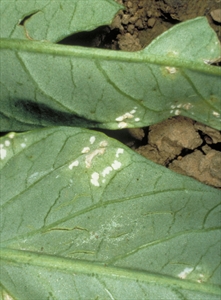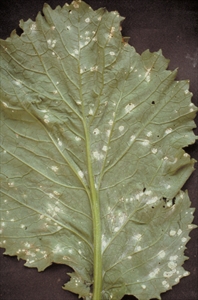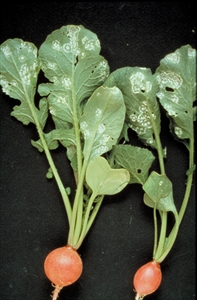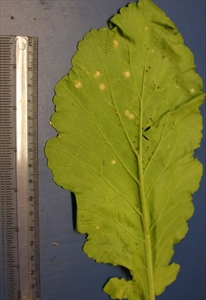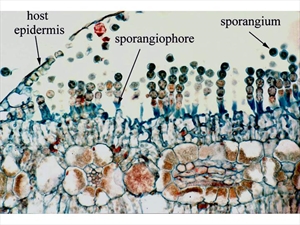White rust, white blister
Pacific Pests, Pathogens, Weeds & Pesticides - Online edition
Pacific Pests, Pathogens, Weeds & Pesticides
Cabbage white rust (134)
Albugo candida. There are different strains. Other species are present in Pacific island countries, for instance, Albugo ipomoeae-aquatica (Photo 1) and Albugo ipomoeae-panduratae.
Asia, Africa, North, South and Central America, the Caribbean, Europe, Oceania. The disease has been recorded in Australia (most brassica species), Cook Islands (Chinese cabbage), Fiji (cabbage, mustard, swede), French Polynesia (mustard), Samoa (Chinese cabbage), and Vanuatu (Chinese cabbage, raddish). Albugo ipomoeae-aquatica occurs in the Pacific islands (Palau and the Federated States of Micronesia), as does Albugo ipomoeae-panduratae (Fiji on sweet potato; and Tonga on Ipomoea species).
Members of the brassica family, e.g., broccoli, Brussels sprouts, cabbage, cauliflower, Chinese cabbage, radish, and cruciferous weeds. Albugo ipomoeae-aquatica (Ipomoea aquatica) and Albugo ipomoeae-panduratae (on sweetpotato and many other Ipomoea species, as well as Convolvulus species.
The disease starts as small white blisters on the leaves, stems and flower stalks. The blisters are closed at first and then burst to release powdery spores, similar to the development of rust pustules, hence the name 'white rust' (Diagram). Later, light green to yellow pustules develop on the upper leaf surface, which grow to 2-3 cm, causing leaves to twist, wither and die. The spores in the pustules are called sporangia, and each sporangia produces several swimming spores called zoospores. After a short time, the zoospores stop swimming, germinate and infect.
Another kind of spore forms in brassicas that produce flowers, e.g., broccoli, when they are infected systemically. Systemic infection occurs when Albugo grows inside the plant. The flowers are deformed: they swell and produce spiky growths that look like antlers, so they are called 'stagheads'. Oospores, which are the result of different strains 'mating', are produced inside these stagheads. The oospores are a survival stage, and remain alive in the soil for many years. Oospores are also found in leaf and stem blisters of broccoli and other brassicas.
Albugo survives in soil, plant debris and infected seed. It is spread short distances when spores in the pustules are splashed in water from infected to healthy plants, and also by insects. Albugo is spread over longer distances in infected plant material, including seeds; in addition, spores in the pustules on leaves, stems and flowers, are spread by wind.
Albugo is a water mould or oomycete; it is not a fungus. It is not a rust either, but it has similarities to rust diseases, for instance, those on peanut (see Fact Sheet no. 34), or maize (see Fact Sheet no. 42).
It is an important disease of brassicas, but one that does best in cool conditions, with heavy dews. It is important because leaves with white blisters are unsightly and have to be removed otherwise they will reduce the market value of their host. The disease is worse on leaves of Chinese cabbage (Photos 2&3), radish (Photo 4), Indian mustard (Photo 5) and kangkong (Photos 6&7), and the heads of broccoli and cauliflower. Leaves can become distorted.
In Samoa, the disease is common on Chinese cabbage (variety Pak Choy) when plants are grown at cooler, higher elevations.
Look for the white blisters on the underside of the older leaves, leaf stalks, stems and flowers. The blisters are round to oval and smooth at first, and then when they burst they release masses of white powdery spores.
QUARANTINE
Albugo exists as a number of strains or races; strains have different host ranges, i.e., those infecting weeds many not infect broccoli or cauliflower. Make sure imported seed is from a reputable source.
CULTURAL CONTROL
The most important way of managing this disease by cultural methods is to use good quality seed, long crop rotations, and to remove debris after harvest.
Before planting:
- Use seed that is of high quality and certified free from Albugo.
- Make nurseries far from production areas, and remove weeds.
- Check seedlings in the nursery, and remove infected plants.
- Remove volunteer brassicas, and weeds, from the production areas.
During growth:
- Irrigate for short periods early in the day, use wide row spacing, and plant in the direction of prevailing winds so leaves dry rapidly.
- Maintain appropriate crop nutrition (particularly adequate potassium and phosphorus) to reduce susceptibility of plants to the disease.
After harvest:
- Remove crop debris (capable of harbouring oospores) and burn or plough in.
- Rotate with non-brassica crops for at least 3 years.
RESISTANT VARIETIES
Grow varieties tolerant or resistant to Albugo . Note, there are no varieties of broccoli that are resistant to cabbage white rust.
CHEMICAL CONTROL
If fungicides are needed in the field, do the following:
- Apply fungicides early, before the disease is serious.
- Alternate protectant products (e.g., copper, mancozeb) with systemic products (e.g., metalaxyl, phosphorus acid), to prevent the development of resistant strains of the oomycete.
____________________
When using a pesticide, always wear protective clothing and follow the instructions on the product label, such as dosage, timing of application, and pre-harvest interval. Recommendations will vary with the crop and system of cultivation. Expert advice on the most appropriate pesticides to use should always be sought from local agricultural authorities.
AUTHOR Grahame Jackson
Information from (including Photos 1&4) Diseases of vegetable crops in Australia (2010). Editors, Denis Persley, et al. CSIRO Publishing, Australia; and from Gerlach WWP (1988) Plant diseases of Western Samoa. Samoan German Crop Protection Project, Deutsche Gesellschaft für Technische Zusammenarbeit (GTZ) Gmbh, Germany; Carr P et al. (2003) White blister (Albugo candida). Vegetable matters-of Facts No. 4. Department of Primary Industries, Victoria. Photos 2&3 Kohler F, et al. (1997) Diseases of cultivated crops in Pacific Island countries. South Pacific Commission. Pirie Printers Pty Limited, Canberra, Australia. Photo 5 Jacquie (Wright) Kami, formerly Plant Pathologist, Secretariat of the Pacific Community, Suva, Fiji. Photos 6&7 Mani Mua, SPC, Sigatoka Research Station, Fiji. Diagram Eric McKenzie (2013) Albugo candida: PaDIL - (http://www.padil.gov.au).
Produced with support from the Australian Centre for International Agricultural Research under project PC/2010/090: Strengthening integrated crop management research in the Pacific Islands in support of sustainable intensification of high-value crop production, implemented by the University of Queensland and the Secretariat of the Pacific Community.
